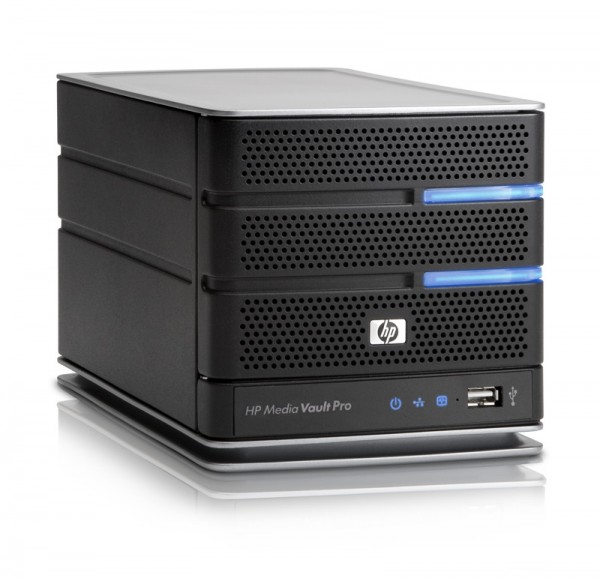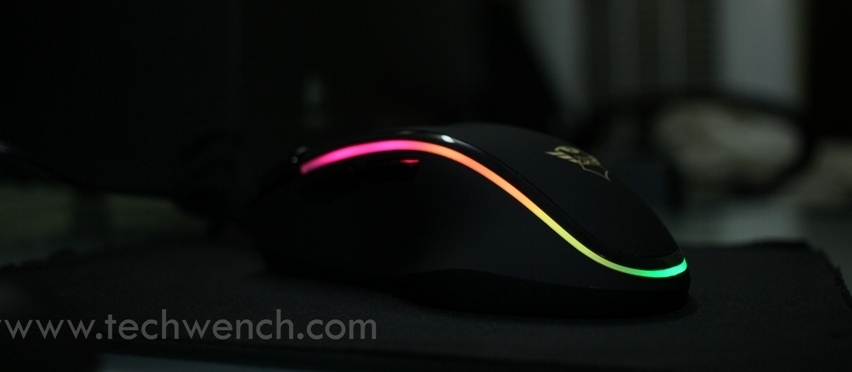
Priced at a cent below 300 dollars, the HP Media Vault mv2120 is an all-around solution to NAS needs, with its versatile storage, backup functionality and file-sharing capabilities for a PC network. It looks like its stable mate the HP MediaSmart Server, only smaller, and priced lower with a Linux OS as opposed to the latter’s Windows Home Server OS. Feature-wise, the mv2120 is replete with lots of user-friendly and cleverly-designed options which, while not perfect, provides user with a satisfactory NAS device experience.
Comparable in size to a bread toaster appliance, the Media Vault mv2120 measures 5.5 by 5.4 by 9.6 inches, and weighs in at a mere ten pounds. A single 500GB hard drive that runs 7,200rpm is included in the standard offering, and the unit itself comes with a detachable bay that can accommodate an additional SATA drive for a larger storage capacity. The front contains light indicators that represent power, connectivity, and drive health. Each bay is also attended by its own drive status lamp, which can be switched on and off or even dimmed using the accompanying software. Copying content to and from the mv2120 is possible using USB external drives plugged to ports in the front and back of the unit. The ports can also accommodate the external drives to expand its storage capacity.
The Media Vault’s attending software contains a quintet of shared folders at default. These folders are named Documents, Backup, Music, Photos and Videos. Additional folders may be added using the configuration tool, which is browser-based, and each can either be public or private. Users can also create secure folders with passwords. When creating a private folder, specific access privileges and rules can be assigned to several users within the network.
The software control surfaces are laid out in a way users will be able to follow easily. A quartet of tabs subdivides the entire control suite under Main, Help and Support, Tools, and Backup. The Main tab contains links to access the shared folders in the Media Vault, as well as a link to its Photo Webshare utility, which is an option for image sharing over the Internet. Backing up the unit’s contents manually to an external drive is done via the Backup tab. The tab also has controls for adjusting the unit’s auto-backup settings. Administration tools are found under the Tools tab, while Help and Support contains various links for accessing the user manual, HP’s website, and their technical help desk.
A strong selling point of the product is its rich file backup functionalities. Users can opt to back up the mv2120’ contents via a simple backup or a one that is user-defined. The simple backup mode can be singularly applied to the default shared folders, or all of them together. In custom mode, preset schedules are used to backup files automatically, with an option to create up to nine separate copies of any file. While these backup modes are convenient, a further functionality would have been a backup option for an e-mail folder. Given that e-mail folder locations vary from application to application as well as from OS platform to OS platform, this is to be expected. A more realistic addition would have been MAC OS X- and Linux-based system support, since the backup utility is only available to PCs running Windows XP and Windows Vista. It doesn’t work with older Windows OS, too, but this is decidedly a minor concern.
The mv2120 also features a detachable drive housing that can be switched in and out even with the system running. This allows a second drive to be added and configured to JBOD or RAID 1 on the fly. Removing and reinserting the housing is made easy because it requires no tool-driven fasteners, such as screws, to keep it slotted in its space in the unit. Feeding an extra 500GB drive into it and slotting it back to the mv2120 will result in an instantly-recognized 500GB additional network storage space. Care should be taken, though, when configuring the new drive. The unit can be set to either JOBD or RAID 1, but once a selection is made the configuration is permanent.
The Media Vault gives users a lot of leeway for doing file-sharing tasks in the form of administrative options pertinent to folder access. The original folder settings allows public access to any folder’s contents, but may be changed for it to become private or even further secured via password. Moreover, only private folders can be accessed remotely. Copying the contents of iTunes libraries in networked PCs to itself is also a nifty feature of the Media Vault to make those contents available to everyone in the network.
The unit demonstrated good write speeds, but is somewhat wanting in the read speed department. Testing its write capabilities, the Media Vault managed a decent 16 minutes, 34 seconds for a 10GB file. Surprisingly, a subsequent read test yielded a positively glacial 15 minutes, 34 seconds for the same 10GB file.
The security features also need a fair bit of work. A major concern is an offshoot of Windows allowing any user only one connection per server at any given time, which meant that connecting to more than one password-secured folder is impossible. HP itself provided a workaround to this problem, wherein the user makes a new password in Windows and then resets all the folders’ password to match it. While this is effective, the process is not exactly standard procedure, nor is it something that buyers of the mv2120 can immediately make use of. Making a folder password-protected also prompts users to provide both the password and a username every time it is accessed, and though the manual states that username is the same as the folder’s name, beginners may have a hard time figuring this out.
Brushing that aside, the Media Vault is still a good purchase with its great remote access capabilities and its attendant online photo sharing accessory. A remote access domain can be used free of charge during the first twelve months after purchase, but users will have to shell out 9 dollars, 99 cents for them to use their domains after the period expires. Like the HP MediaSmart Server, a remote access setup requires an open port on the router to be useable, a task which can only be done manually. The photo accessory is a Nifty feature for sharing images with other over the internet, but is a tad cumbersome since it only allows one photo upload at a time.
Another great feature of the Media Vault mv2120 is its capability to do external USB drive backups to its folder contents. Transferring files from local to USB drive is quick and simple, but once moved the files are difficult to return to where they came from. The only way to restore the files to their original locations is by copying them one by one and pasting them back to their previous folders. Perhaps a command in the software that can do this in one click would have been helpful, but this is not so. Expanding network storage via one or two external USB drives connected to the Media Vault is another great functionality of the unit.
HP is to be lauded for coming up with a NAS device that caters to everyone, and for adding a bunch of other features to it along the way. A considerable number of issues somewhat downplay this otherwise great product, though, particularly in the way password-secured folders work with the system as well as some aspects of the interface. Users who can manage to overlook these and focus instead on the unit’s great backup and file sharing capabilities will find a superb product in the HP Media Vault mv2120.










Comments